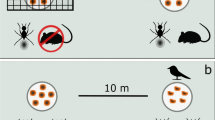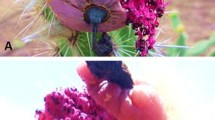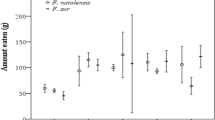Abstract
This study examines the dispersal system of Guapira opposita in a tropical sandy rainforest in southeast Brazil. Guapira trees produce small fruits with a high protein content (28.4%) and low lipid content (0.3%), and the plant is primarily dispersed by birds. Mature fruits of G. opposita can fall spontaneously with the pulp intact, or be dropped by birds with bits of pulp attached. In either case, ground-dwelling ants rapidly remove the fruits to their nest (93% after 12 h). The ponerine ants Odontomachus chelifer and Pachycondyla striata are the main seed vectors among the ants, and together account for 56% (20 of 36) of the ant-fruit interactions recorded on the forest floor. Individual workers of O. chelifer and P. striata transport single fruits to their nests. Bits of pulp are fed to larvae and worker nestmates, and intact seeds are discarded outside the nest. Germination success in Guapira is higher for cleaned seeds (pulp removed) than for seeds coated by pulp. Guapira seedlings and juveniles are more frequent close to Odontomachus nests than at sites without such nests. Soil samples from Odontomachus nests had greater penetrability, and higher concentrations of P, K, and Ca than random soil samples. Field experiments suggest that the association between G. opposita seedlings and O. chelifer nests can potentially render the plant some protection against herbivores. Results indicate that fruit displacement by ponerine ants play an important role in the biology of G. opposita seeds and seedlings in the sandy forest, and illustrate the complex nature of the dispersal ecology of tropical tree species.


Similar content being viewed by others
References
Auspurger CK, Kelly CK (1984) Pathogen mortality of tropical tree seedlings: experimental studies of the effects of dispersal distance, seedling density, and light conditions. Oecologia 61:211–217
Barros F, Melo MMRF, Chiea SAC, Kirizawa M, Wanderley MGL, Jung-Mendaçolli SL (1991) Flora fanerogâmica da Ilha do Cardoso, vol. 1. Instututo de Botânica, São Paulo
Basset Y (1999) Diversity and abundance of insect herbivores foraging on seedlings in a rainforest in Guyana. Ecol Entomol 24:245–259
Beattie AJ (1985) The evolutionary ecology of ant-plant mutualisms. Cambridge University Press, Cambridge
Beattie AJ, Turner CL, Knox RB (1986) Antibiotic production: a possible function for the metapleural glands of ants (Hymenoptera: Formicidae). Ann Entomol Soc Am 79:448–450
Bligh EG, Dyer WJ (1959) A rapid method of total lipid extraction and purification. Can J Biochem Physiol 37:911–917
Böhning-Gaese K, Gaese BH, Rabemanantsoa SB (1999) Importance of primary and secondary seed dispersal in the Malagasy tree Commiphora guillaumini. Ecology 80:821–832
Brew CR, O’Dowd DJ, Rae ID (1989) Seed dispersal by ants: behaviour-releasing compounds in elaiosomes. Oecologia 80:490–497
Byrne MM (1994) Ecology of twig-dwelling ants in a wet lowland tropical forest. Biotropica 26:61–72
Carroll CR, Janzen DH (1973) Ecology of foraging by ants. Annu Rev Ecol Syst 4:231–257
Corlett RT (1996) Characteristics of vertebrate-dispersed fruits in Hong Kong. J Trop Ecol 12:819–833
Davidson DW (1988) Ecological studies of neotropical ant-gardens. Ecology 69:1138–1152
Davidson DW, Epstein WW (1989) Epiphytic associations with ants. In: Lüttge U (ed) Phylogeny and ecophysiology of epiphytes. Springer, Berlin Heidelberg New York, pp 200–233
Denslow JS, Gomez-Dias AE (1990) Seed rain to treefall gaps in a neotropical rain forest. Can J For Res 20:815–817
Denslow JS, Vitousek PM, Schultz JC (1987) Bioassays of nutrient limitation in a tropical rain forest soil. Oecologia 74:370–376
Farji-Brener AG, Medina CA (2000) The importance of where to dump the refuse: seed bank and fine roots in nests of the leaf-cutting ants Atta cephalotes and Atta colombica. Biotropica 32:120–126
Foster RB (1982) The seasonal rhythm of fruitfall on Barro Colorado Island. In: Leigh EG, Rand AS, Windsor DM (eds) The ecology of a tropical forest: seasonal rhythms and long-term changes. Smithsonian Institution Press, Washington, pp 151–172
Fourcassié V, Oliveira PS (2002) Foraging ecology of the giant Amazonian ant Dinoponera gigantea (Hymenoptera, Formicidae, Ponerinae): activity schedule, diet, and spatial foraging patterns. J Nat Hist 36:2211–2227
Frankie GW, Baker HG, Opler PA (1974) Comparative phenological studies of trees in tropical wet and dry forests in the lowlands of Costa Rica. J Ecol 62:881–919
Galetti M (1996) Fruits and frugivores in a Brazilian Atlantic forest. PhD thesis, Cambridge University, Cambridge
Galetti M, Laps R, Pizo MA (2000) Frugivory by toucans (Ramphastidae) at two altitudes in the Atlantic forest of Brazil. Biotropica 32:842–850
Garrido JL, Rey PJ, Cerdá X, Herrera CM (2002) Geographical variation in diaspore traits of an ant-dispersed plant (Helleborus foetidus): are ant community composition and diaspore traits correlated? J Ecol 90:446–455
Garwood NC (1983) Seed germination in a seasonal tropical forest in Panama: a community study. Ecol Monogr 53:159–181
Handel SN, Beattie AJ (1990) Seed dispersal by ants. Sci Am 263:76–83A
Herrera CM (1987) Vertebrate-dispersed plants of the Iberian Peninsula: a study of fruit characteristics. Ecol Monogr 57:305–331
Herrera CM, Jordano P, López-Soria L, Amat JA (1994) Recruitment of a mast-fruiting, bird-dispersed tree: bridging frugivore activity and seedling establishment. Ecol Monogr 64:315–344
Hölldobler B, Wilson EO (1990) The ants. Belknap Press, Cambridge, Mass.
Horvitz CC (1981) Analysis of how ant behavior affects germination in a tropical myrmecochore Calathea microcephala (P. & E.) Koernicke (Marantaceae): microsite selection and aril removal by neotropical ants, Odontomachus, Pachycondyla, and Solenopsis (Formicidae). Oecologia 51:47–52
Horvitz CC, Beattie AJ (1980) Ant dispersal of Calathea (Marantaceae) by carnivorous Ponerines (Formicidae) in a tropical rain forest. Am J Bot 67:321–326
Horvitz CC, Le Corff J (1993) Spatial scale and dispersal pattern of ant- and bird-dispersed herbs in two tropical lowland rain forests. Vegetatio 107/108:351–362
Horvitz CC, Schemske DW (1986a) Seed dispersal of a neotropical myrmecochore: variation in removal rates and dispersal distance. Biotropica 18:319–323
Horvitz CC, Schemske DW (1986b) Ant-nest soil and seedling growth in a neotropical ant-dispersed herb. Oecologia 70:318–320
Howe HF (1989) Scatter- and clump-dispersal and seedling demography: hypothesis and implications. Oecologia 79:417–426
Howe HF, Schupp EW (1985) Early consequences of seed dispersal for a neotropical tree (Virola surinamensis). Ecology 66:781–791
Hughes L, Westoby M (1992) Fate of seeds adapted for dispersal by ants in Australian sclerophyll vegetation. Ecology 73:1285–1299
Jordano P (1993) Fruits and frugivory. In: Fenner M (ed) Seeds: the ecology of regeneration in plant communities. CAB International, Wallingford, pp 105–156
Kaspari M (1993) Removal of seeds from neotropical frugivore feces: ants responses to seed number. Oecologia 95:81–88
Kaufmann S, McKey DB, Hossaert-McKey M, Horvitz CC (1991) Adaptations for a two-phase seed dispersal system involving vertebrates and ants in a hemiepiphytic fig (Ficus microcarpa: Moraceae). Am J Bot 78:971–977
Leal IR, Oliveira PS (1998) Interactions between fungus-growing ants (Attini), fruits and seeds in cerrado vegetation in southeast Brazil. Biotropica 30:170–178
Levey DJ, Byrne MM (1993) Complex ant-plant interactions: rain forest ants as secondary dispersers and post-dispersal seed predators. Ecology 74:1802–1812
Lieberman D (1996) Demography of tropical tree seedlings: a review. In: Swaine MD (ed) Ecology of tropical forest tree seedlings. UNESCO/Parthenon, Paris/Carnforth, pp 131–135
Marshall DL, Beattie AJ, Bollenbacher WE (1979) Evidence for diglycerides as attractants in an ant-seed interaction. J Chem Ecol 5:335–343
Morellato LPC, Talora DC, Takahasi A, Bencke CC, Romera EC, Zipparro VB (2000) Phenology of Atlantic rain forest trees: a comparative study. Biotropica 32:811–823
Oliveira PS, Galetti M, Pedroni F, Morellato LPC (1995) Seed cleaning by Mycocepurus goeldii ants (Attini) facilitates germination in Hymenaea courbaril (Caesalpiniaceae). Biotropica 27:518–522
Oliveira-Filho AT, Fontes MAL (2000) Patterns of floristic differentiation among Atlantic forests in southeastern Brazil and the influence of climate. Biotropica 32:793–810
Passos L (2001) Ecologia da interação entre formigas, frutos e sementes em solo de mata de restinga. PhD thesis, Universidade Estadual de Campinas, Campinas, Brazil
Passos L, Oliveira PS (2002) Ants affect the distribution and performance of Clusia criuva seedlings, a primarily bird-dispersed rainforest tree. J Ecol 90:517–528
Passos L, Oliveira PS (2003) Interactions between ants, fruits, and seeds in a restinga forest in south-eastern Brazil. J Trop Ecol 19:261–270
Pijl L van der (1982) Principles of dispersal in higher plants. Springer, Berlin Heidelberg New York
Pizo MA, Oliveira PS (1998) Interactions between ants and seeds of a nonmyrmecochorous neotropical tree, Cabralea canjerana (Meliaceae), in the Atlantic forest of southeast Brazil. Am J Bot 85:669–674
Pizo MA, Oliveira PS (2000) The use of fruits and seeds by ants in the Atlantic forest of southeast Brazil. Biotropica 32:851–861
Pizo MA, Oliveira PS (2001) Size and lipid content of nonmyrmecochorous diaspores: effects on the interaction with litter-foraging ants in the Atlantic rain forest of Brazil. Plant Ecol 157:37–52
Pizo MA, Passos L, Oliveira PS (2004) Ants as seed dispersers of fleshy diaspores in Brazilian Atlantic forests. In: Forget P-M, Lambert JE, Hulme PE, Vander Wall SB (eds) Seed fate: predation and secondary dispersal. CABI, Wallingford (in press)
Roberts JT, Heithaus ER (1986) Ants rearrange the vertebrate-generated seed shadow of a neotropical fig tree. Ecology 67:1046–1051
Schupp EW (1993) Quantity, quality and the effectiveness of seed dispersal by animals. Vegetatio 107/108:15–29
Schupp EW (1995) Seed-seedling conflicts, habitat choices, and patterns of plant recruitment. Am J Bot 82:399–409
Steven D (1994) Tropical tree seedlings dynamics: recruitment patterns and their population consequences for three canopy species in Panama. J Trop Ecol 10:369–383
Traveset A (1998) Effect of seed passage through vertebrate frugivores’ guts on germination: a review. Perspect Plant Ecol Evol Syst 1/2:151–190
Wang BC, Smith TB (2002) Closing the seed dispersal loop. Trends Ecol Evol 17:379–385
Zar JH (1999) Biostatistical analysis. Prentice Hall, New Jersey
Acknowledgements
We are grateful to B. Loiselle, M.A. Pizo, A.V. Freitas, K.S. Brown, C.R.F. Brandão, F.M. Santos, H.P. Dutra, and W.R. Silva for helpful suggestions on the manuscript. We also thank G. Machado, T. Quental, and A. Guerreiro for help during field work, A. Mayhé-Nunes and I.R. Leal for ant identification. Chemical analyses of the fruits were performed at the Instituto de Tecnologia de Alimentos; soil analyses were undertaken at the Instituto Agronômico de Campinas. We are grateful to the Instituto Florestal do Estado de São Paulo for allowing us to work at Ilha do Cardoso. The Brazilian Research Council (CNPq) supported the study through a doctoral fellowship to L.P., and a research grant to P.S.O.
Author information
Authors and Affiliations
Corresponding author
Rights and permissions
About this article
Cite this article
Passos, L., Oliveira, P.S. Interaction between ants and fruits of Guapira opposita (Nyctaginaceae) in a Brazilian sandy plain rainforest: ant effects on seeds and seedlings. Oecologia 139, 376–382 (2004). https://doi.org/10.1007/s00442-004-1531-5
Received:
Accepted:
Published:
Issue Date:
DOI: https://doi.org/10.1007/s00442-004-1531-5




